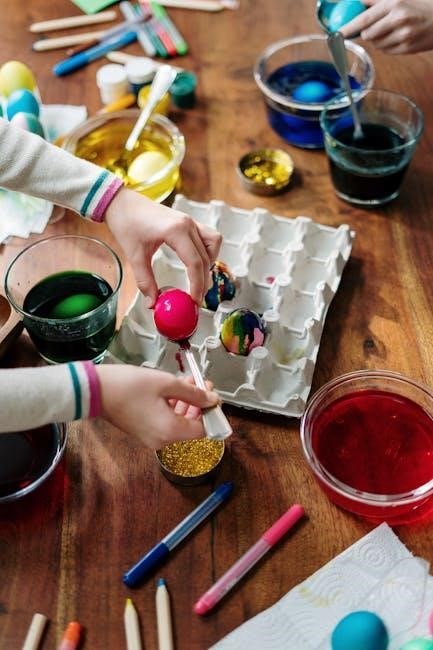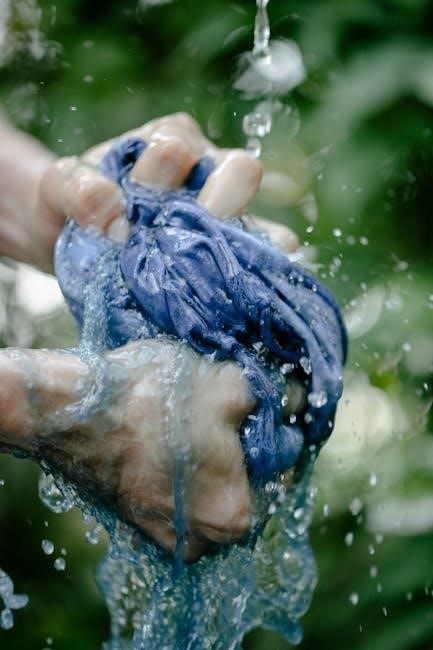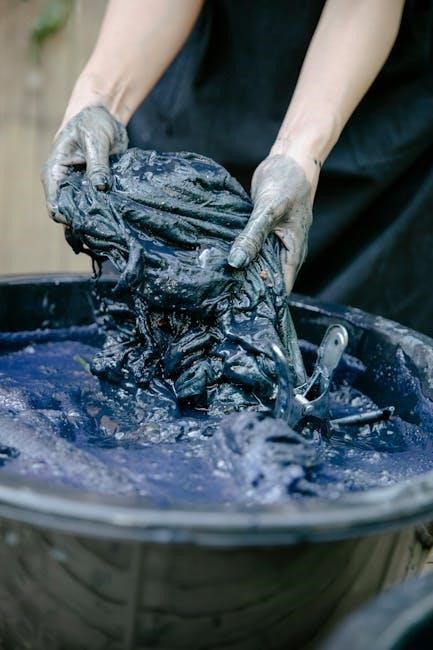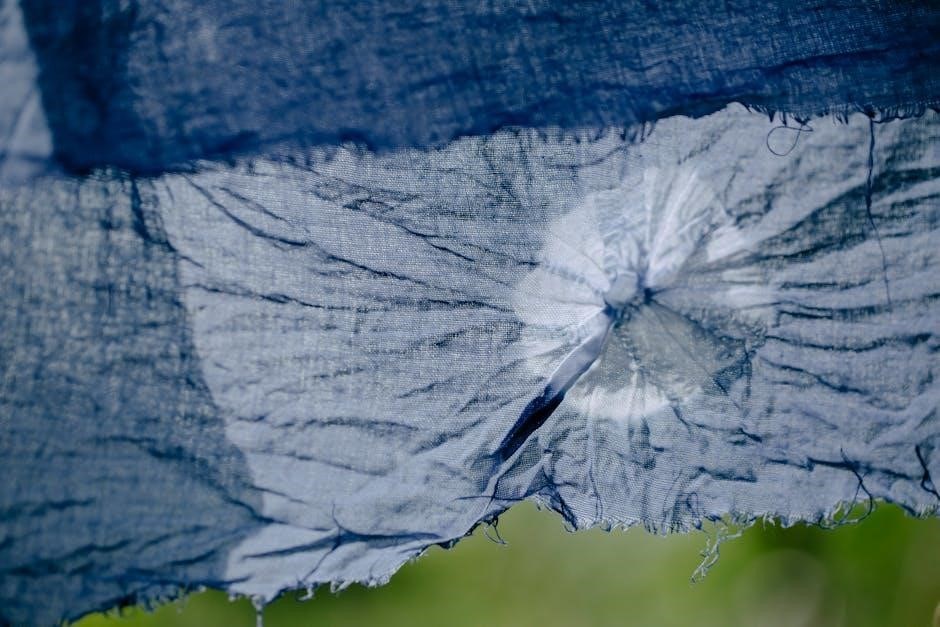Tie-dye washing instructions are essential for preserving vibrant colors and preventing dye bleeding. Proper techniques ensure long-lasting designs, making fabrics look fresh after multiple washes. This guide provides detailed steps to care for your tie-dye creations effectively.
Understanding the Basics of Tie-Dye
Tie-dye involves folding, twisting, or binding fabric to create unique patterns. The process requires rubber bands or ties to secure folds tightly, as wet fabric expands. A mordant, like a metal salt, helps bond dye to fibers, ensuring vibrant colors. Dyes must set for at least 6-24 hours. Fabric type, such as cotton or polyester, affects dye absorption. Proper washing techniques are crucial to prevent fading and bleeding, keeping designs intact.
Importance of Proper Washing Techniques
Proper washing techniques are vital to preserve tie-dye colors and prevent fading. Improper methods can cause dye bleeding or discoloration. Using cold water, mild detergents, and avoiding bleach or fabric softeners helps maintain vibrant designs. Fixing agents or vinegar can enhance color retention. Regular washing practices ensure the fabric remains soft and the tie-dye patterns stay intact over time, extending the life of your uniquely designed garments.

Materials Needed for Tie-Dye Washing
Cold water, mild detergent, and a fixing agent like vinegar are essential. Soft-bristled brushes and rubber bands help gently remove excess dye and maintain the design during washing.
Essential Supplies for Washing Tie-Dye Fabrics
For washing tie-dye fabrics, you’ll need cold water, a mild detergent, and a fixing agent like vinegar to preserve colors. Rubber bands or ties are useful for securing folds, while soft-bristled brushes can gently remove excess dye. Optional supplies include gloves to protect hands and a bucket for soaking. These materials ensure a gentle washing process that maintains the fabric’s vibrant design and prevents color bleeding.
- Cold water
- Mild detergent
- Vinegar or fixing agent
- Rubber bands or ties
- Soft-bristled brush
- Gloves (optional)
- Bucket for soaking (optional)
Recommended Detergents and Additives
Use mild detergents without bleach or fabric softeners to protect tie-dye colors. Additives like vinegar or commercial color-fixing agents help lock in dyes, reducing bleeding. Opt for eco-friendly detergents designed for colorful fabrics. Avoid harsh chemicals that damage fibers and fade designs. Cold water is best for washing to preserve vibrancy and maintain the integrity of the tie-dye pattern.
- Mild detergent (e.g., Seventh Generation or Ecover)
- Vinegar or color-fixing agents
- Cold water
- Eco-friendly or color-protecting detergents

Initial Rinse and Preparation
Rinse tie-dye fabrics under cold water to remove excess dye before washing. Gently squeeze out water without wringing. This step prevents color bleeding and prepares fabric for washing.
How to Remove Excess Dye Before Washing
Turn the tie-dye garment inside out and rinse under cold running water to remove loose dye. Gently squeeze excess water without wringing or twisting. Repeat until the water runs clear. This step prevents color bleeding and ensures the dye sets properly. Avoid soaking, as it may damage the fabric. Properly removing excess dye is crucial for maintaining vibrant colors and preventing fading during future washes.
Preparing Fabric for the First Wash
Allow the tie-dye fabric to set for at least 6-24 hours after dyeing to ensure the colors bond properly. Before washing, turn the garment inside out to protect the design. Consider soaking it in cold water with a vinegar solution (1 part vinegar to 4 parts water) for 10-15 minutes to fix the dye. This step helps lock in colors, reducing bleeding and fading during the first wash.

Washing Instructions for Tie-Dye Fabrics
Use cold water and mild detergent to wash tie-dye fabrics. Avoid bleach or fabric softeners. Hand washing is ideal, but machine washing on a gentle cycle works too.
Hand Washing vs. Machine Washing
Hand washing is ideal for tie-dye fabrics as it gently removes excess dye without agitating the fabric. Machine washing is acceptable if done on a gentle cycle with cold water. Use a mild detergent and avoid bleach or fabric softeners. For machine washing, place the garment in a mesh laundry bag to protect it from friction. Hand washing prevents color fading and maintains fabric integrity, while machine washing is convenient but may cause slight color bleeding over time.
Best Practices for Cold Water Washing
Cold water washing is crucial for preserving tie-dye colors and preventing fading. Use a mild detergent free of bleach or harsh chemicals. Turn garments inside out to protect the design. For machine washing, select a gentle cycle with cold water and consider placing items in a mesh laundry bag. Avoid fabric softeners, as they can damage the dye. Cold water minimizes color bleeding and ensures vibrant, long-lasting results for your tie-dye creations.

Drying and Ironing Tie-Dye Fabrics
Dry tie-dye fabrics by air-drying or tumble-drying on low heat. Iron inside out on a low setting to avoid damaging colors. Avoid direct heat on dyed areas.

Proper Drying Techniques to Preserve Colors
Air-drying tie-dye fabrics is ideal to preserve colors, as machine drying can cause fading. If using a dryer, select a low heat setting and remove garments while slightly damp. Avoid direct sunlight, as it may bleach colors. For ironing, use a low setting and iron inside out to protect the dye. These methods ensure vibrant colors remain intact and prevent excessive fading over time.
Ironing Tips for Tie-Dye Garments
When ironing tie-dye garments, use a low heat setting to prevent color fading and fabric scorching. Ironing on the inside of the fabric is recommended to protect the dye. Avoid using steam, as it may affect the dye’s integrity. Consider using a pressing cloth for extra protection. For best results, iron while the fabric is slightly damp. Patience is key; take your time to gently remove wrinkles without rushing. This approach preserves the vibrant colors and unique patterns of your tie-dye garments.

Preventing Color Fading
Preventing color fading requires using fixing agents or vinegar during rinsing to lock in dyes. Wash tie-dye fabrics in cold water with mild detergents to preserve vibrancy and minimize fading over time.
Using Fixing Agents or Vinegar

Using fixing agents or vinegar helps lock dye into fabric, preventing fading. Add a fixing agent or 1 cup of white vinegar to the final rinse in cold water. This step ensures colors stay vibrant and reduces bleeding. Fixing agents create a chemical bond between dye and fabric, while vinegar naturally seals colors. Both methods are effective for preserving tie-dye designs and maintaining their intensity over multiple washes.
Minimizing Color Bleeding Over Time
To minimize color bleeding, use cold water for washing and avoid harsh detergents or bleach. Adding a fixing agent or vinegar during the rinse helps secure colors. Air drying instead of using a dryer reduces friction and heat that can cause fading. Washing tie-dye items separately and turning them inside out protects the design. Gentle care ensures vibrant colors last longer and prevents dye from bleeding over time.

Common Mistakes to Avoid
Common mistakes include using hot water, harsh detergents, and over-rinsing, which can cause colors to bleed. Avoid soaking tie-dye fabrics for too long and always fix colors before washing to ensure lasting vibrancy.
Improper Dye Application and Washing Errors
Improper dye application, such as uneven folding or loose ties, can lead to inconsistent patterns. Washing errors like using hot water or harsh detergents can cause colors to bleed or fade. Over-rinsing or soaking fabrics for too long may also damage the dye bond. Failure to use fixing agents, like vinegar, during the rinse can result in poor color retention. These mistakes can ruin the design and reduce the fabric’s vibrancy over time.
How to Fix Issues with Faded or Bleeding Colors
To address faded or bleeding colors, start by rinsing the fabric in cold water with a mild detergent. Add a fixing agent like vinegar to help set the dyes and prevent further bleeding. Avoid fabric softeners and hot water, as they can exacerbate color loss. For severe fading, consider re-dyeing the fabric or using color fixatives. Air drying instead of machine drying can also help preserve the colors and prevent additional fading.

Care and Maintenance of Tie-Dye Fabrics
Proper care involves washing tie-dye fabrics inside out in cold water with mild detergent. Avoid bleach and fabric softeners. Store in a cool, dry place to preserve colors.
Long-Term Care Tips for Tie-Dye Garments
For long-lasting tie-dye designs, wash garments inside out in cold water with a mild detergent. Avoid bleach and fabric softeners, as they can degrade colors. Dry naturally or tumble dry on low heat to prevent fading. Store tie-dye items in a cool, dark place to protect colors from sunlight. Regular washing with gentle care ensures vibrant patterns remain intact over time. Proper storage and handling also prevent creasing and damage.
Storage and Handling Recommendations
Store tie-dye garments in a cool, dark place to protect colors from fading. Use breathable fabric bags or acid-free tissue paper to maintain freshness. Avoid folding or stacking, as this may cause creases or color transfer. Hang items using padded hangers to preserve shapes and prevent stretching. Ensure garments are completely dry before storage to prevent mold. Keep them away from direct sunlight and pests, using natural deterrents like lavender sachets instead of mothballs. This maintains vibrant colors and fabric integrity over time.
Proper washing preserves tie-dye colors and design. Use cold water, mild detergent, and avoid fabric softeners. Follow these steps to keep your tie-dye vibrant and intact.
For tie-dye fabrics, use cold water and mild detergent to prevent color fading. Avoid bleach and fabric softeners. Gently rinse excess dye before washing. Hand washing is recommended, but if using a machine, choose a gentle cycle. Line drying preserves colors best. Vinegar can help fix dyes and minimize bleeding. Proper care ensures vibrant, long-lasting tie-dye designs.
Final Tips for Preserving Tie-Dye Designs
To keep your tie-dye vibrant, wash in cold water with a mild detergent and avoid bleach or fabric softeners. Gently remove excess dye before the first wash. Air-dry garments or tumble dry on low heat. For extra protection, add vinegar during the rinse cycle to fix colors. Store tie-dye items separately to prevent friction and fading. By following these steps, your designs will remain bold and colorful for years to come.